-
 Rap1-GFP and Calcofluor White staining of stationary phase cells.
Rap1-GFP and Calcofluor White staining of stationary phase cells.
Image courtesy of M. Guidi, M. Ruault and A. Taddei, Institut Curie (Paris). -
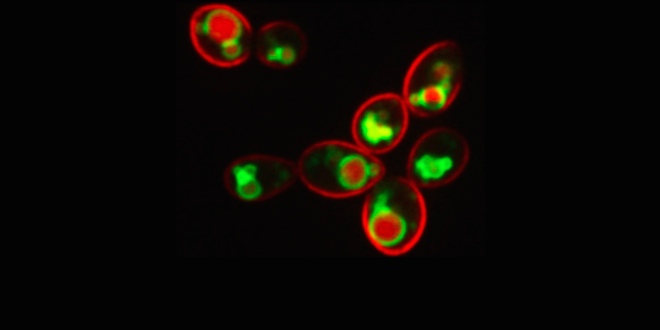 Pma1-mCherry and Vma1-GFP localization in mitotic cells.
Pma1-mCherry and Vma1-GFP localization in mitotic cells.
Image courtesy of M. Eastwood, Fred Hutch and M. Meneghini, University of Toronto. -
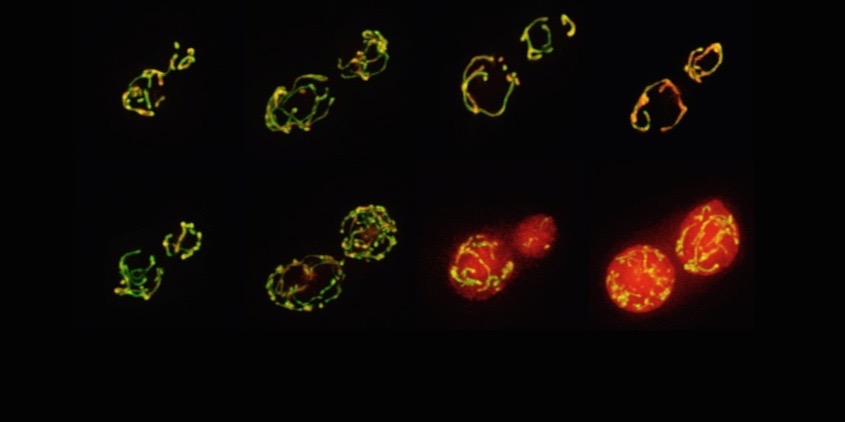 CCCP-induced decrease of mitochondrial membrane potential (below) or control treatment (above) as measured by MitoLoc.
CCCP-induced decrease of mitochondrial membrane potential (below) or control treatment (above) as measured by MitoLoc.
Image courtesy of Dr. Jakob Vowinckel, Ralser Lab, University of Cambridge. -
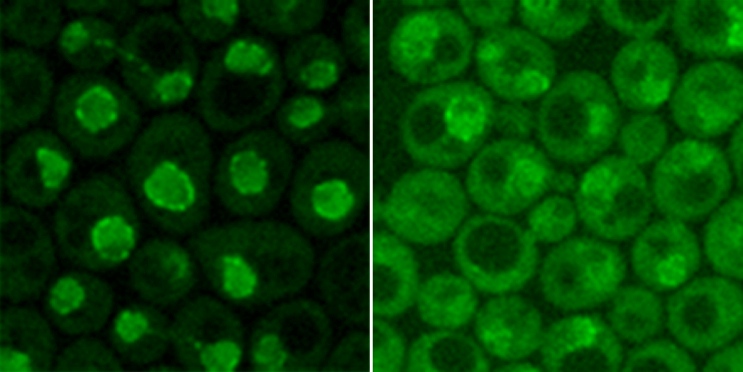 Redistribution of Msn5 pools from the nucleus to the cytoplasm upon glucose deprivation.
Redistribution of Msn5 pools from the nucleus to the cytoplasm upon glucose deprivation.
Image courtesy of H. Huang and A. Hopper, Ohio State University. -
 Floccule of yeast rho0 cells expressing PTS1-GFP as a peroxisomal marker, stained with calcofluor white.
Floccule of yeast rho0 cells expressing PTS1-GFP as a peroxisomal marker, stained with calcofluor white.
Image courtesy of Dr. Jakob Vowinckel, University of Cambridge -
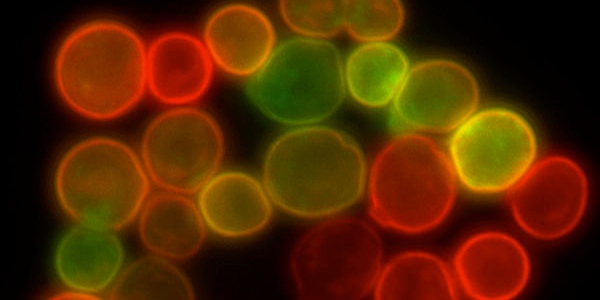 S. cerevisiae membrane proteins visualized by RFP and GFP.
S. cerevisiae membrane proteins visualized by RFP and GFP.
Image courtesy of Masur. Wikimedia Commons. -
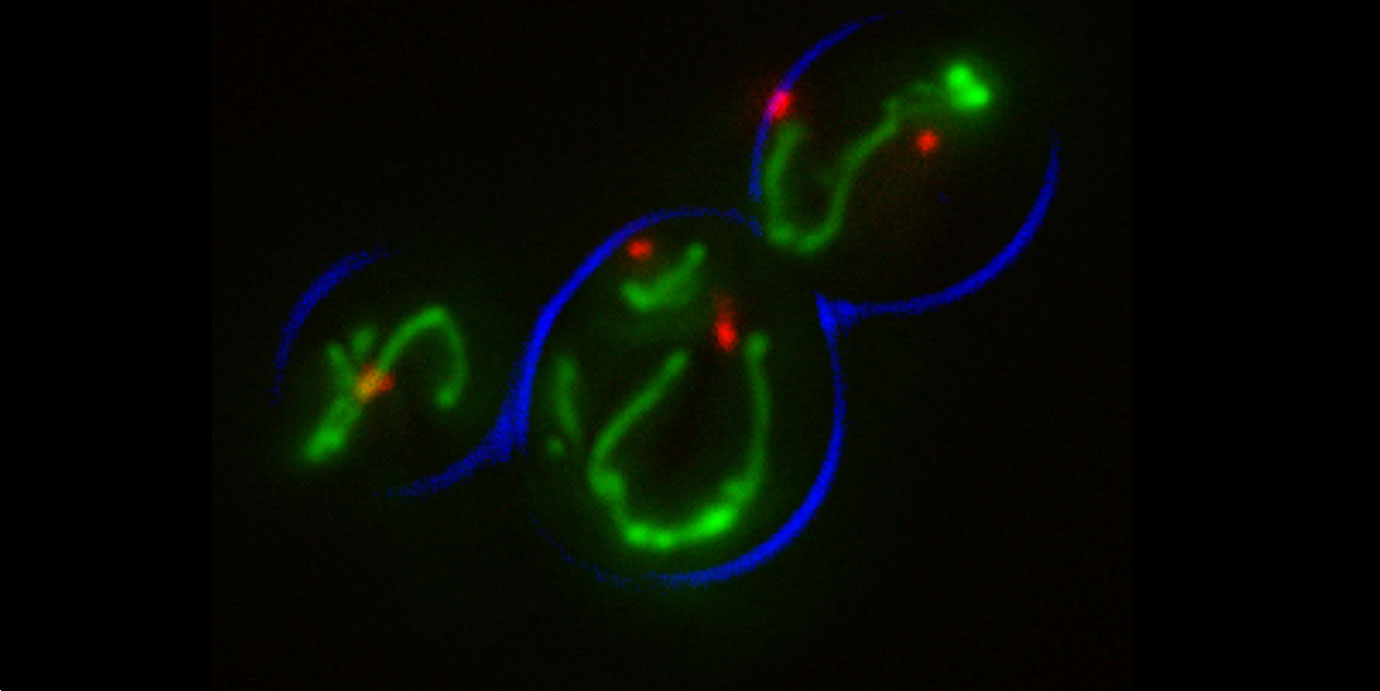 Peroxisome (red) and mitochondrial (green) fission defects in vps1 fis1 double deletion strain transformed with FIS1.
Peroxisome (red) and mitochondrial (green) fission defects in vps1 fis1 double deletion strain transformed with FIS1.
Image courtesy of S. Lefevre, S. Kumar and I. van der Klei, University of Groningen. -
 Yeast cells expressing TRK1/GFP.
Yeast cells expressing TRK1/GFP.
Image courtesy of V. Zayats and J. Ludwig, Center of Nanobiology and Structural Biology, AV CR. -
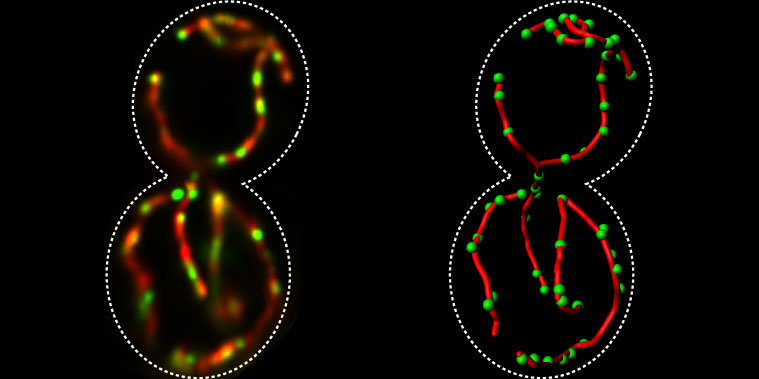 The distribution of mtDNA (green) within the mitochondrial network (red).
The distribution of mtDNA (green) within the mitochondrial network (red).
Image courtesy of Christof Osman and Peter Walter, University of California, San Francisco -
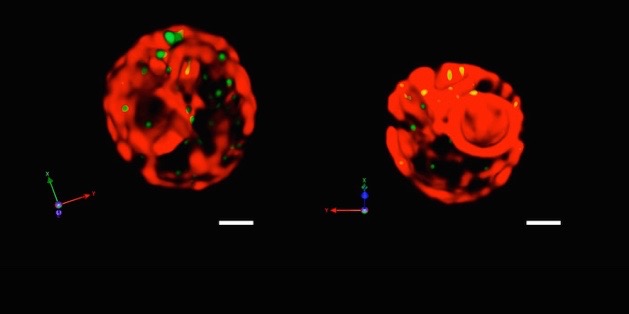 The distribution of ER exit sites (ERES, green) within the ER (red).
The distribution of ER exit sites (ERES, green) within the ER (red).
Image courtesy of A. Nakano and K. Kurokawa, RIKEN. -
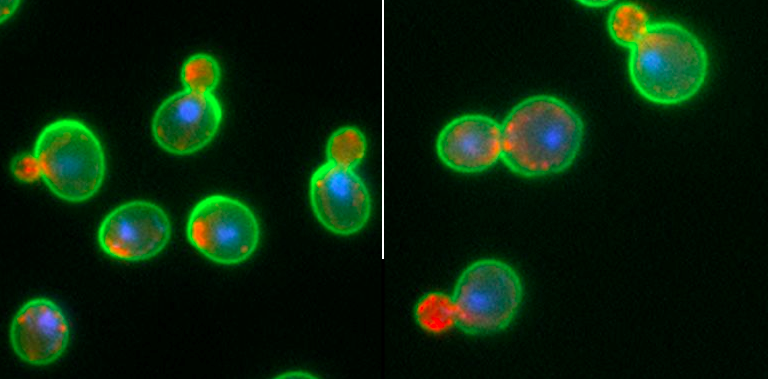 Cell, actin and nuclear morphology of yeast cells treated with DMSO (left) and poacic acid (right).
Cell, actin and nuclear morphology of yeast cells treated with DMSO (left) and poacic acid (right).
Images courtesy of Hiroki Okada and Yoshikazu Ohya, University of Tokyo. -
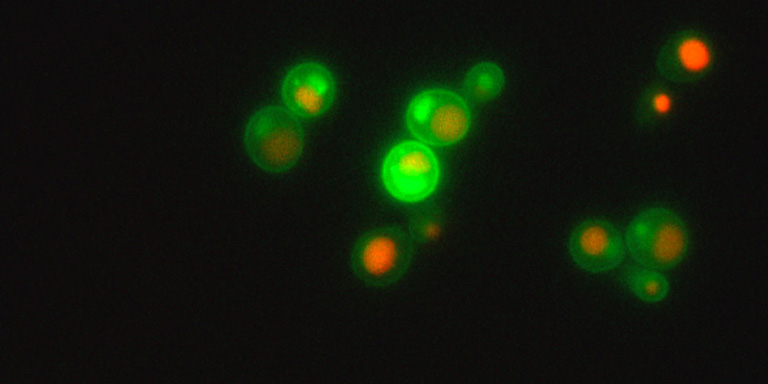 Localization of active Ras in a wild type strain
Localization of active Ras in a wild type strain
Image courtesy of S. Colombo and E. Martegani, University Milano Bicocca -
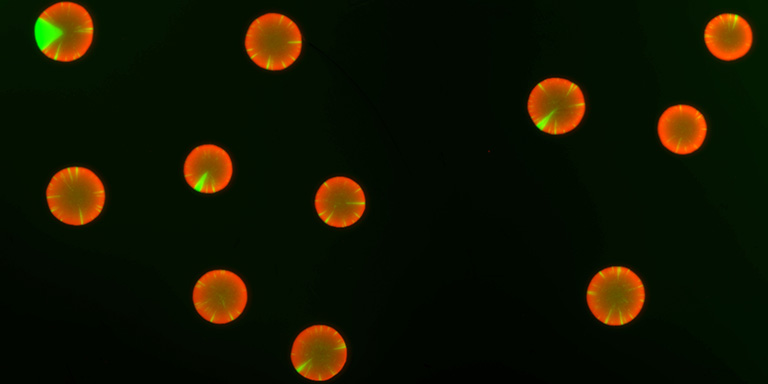 Sectored colonies showing loss of silencing at the HML locus
Sectored colonies showing loss of silencing at the HML locus
Image courtesy of Anne Dodson, UC Berkeley -
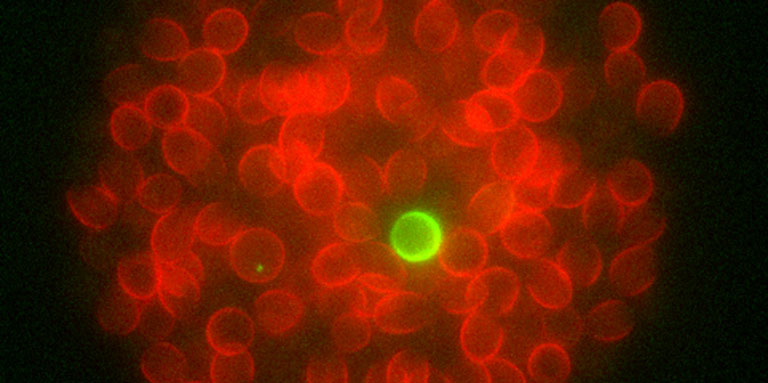 Pma1p imaged using the RITE tagging system in mother (green) and daughter cells (red)
Pma1p imaged using the RITE tagging system in mother (green) and daughter cells (red)
Image courtesy of Dan Gottschling Ph.D., Fred Hutchinson Cancer Research Center -
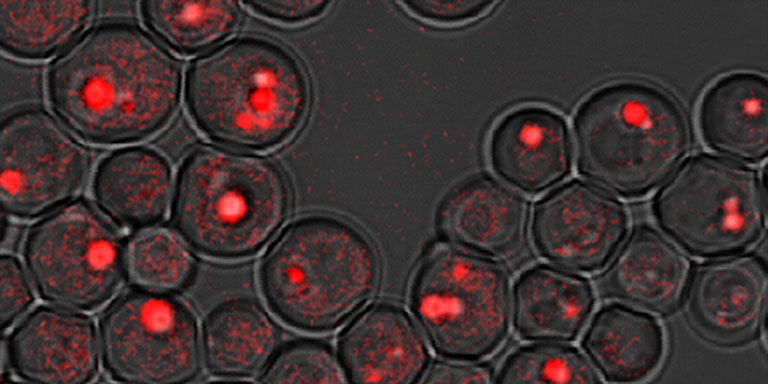 Lipid droplets in fld1 mutant images by CARS
Lipid droplets in fld1 mutant images by CARS
Image courtesy of Heimo Wolinski, Ph.D. and Sepp D. Kohlwein, Ph.D., University of Graz, Austria -
 Fpr3p accumulation in the nucleolus of S. cerevisiae
Fpr3p accumulation in the nucleolus of S. cerevisiae
Image courtesy of Amy MacQueen, Ph.D., Wesleyan University
anti-Fpr3 antibody courtesy of Jeremy Thorner, Ph.D., UC Berkeley -
 San1 strain visualized with FUN and calcofluor white
San1 strain visualized with FUN and calcofluor white
Image courtesy of the Bruschi lab, ICGEB, Trieste, Italy -
 Single MDN1 mRNAs detected by FISH
Single MDN1 mRNAs detected by FISH
Image courtesy of the Zenklusen Lab, Université de Montréal -
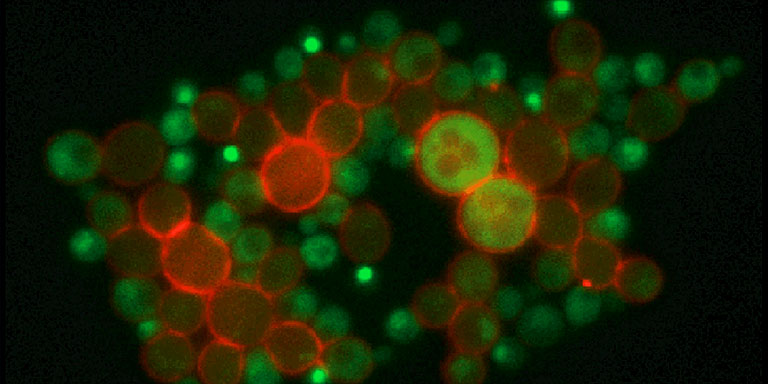 Localization of Ace2-GFP to daughter cell nuclei
Localization of Ace2-GFP to daughter cell nuclei
Image courtesy of Eric Weiss, Ph.D. Northwestern University
About SGD
The Saccharomyces Genome Database (SGD) provides comprehensive integrated biological information for the budding yeast Saccharomyces cerevisiae along with search and analysis tools to explore these data, enabling the discovery of functional relationships between sequence and gene products in fungi and higher organisms.
Upcoming Meetings
Rocky Mountain Yeast Conference
January 8, 2016 - Colorado State University, Fort Collins CO, USA
Registration deadline: December 28, 2015Biocuration 2016
April 10, 2016 - Geneva, Switzerland
Abstract deadline: February 1, 201612th Yeast Lipid Conference
May 20, 2016 - Ghent, Belgium
Gene transcription in yeast: From chromatin to RNA and back
June 11, 2016 - Sant Feliu de Guixols, Spain
Abstract deadline: March 14, 2016PYFF6 - 6th Conference on Physiology of Yeast and Filamentous Fungi
July 11, 2016 - University of Lisbon, Lisbon, Portugal
New & Noteworthy
- Keeping Gen(i)e Drives in Their Lamps
12/02/2015
Everyone knows about genies. They have almost infinite power, can grant you three wishes, and are kept under control by the owner of their lamp. And as we saw in Disney’s Aladdin, it is a good thing that the lamp is around! When the evil sorcerer Jafar was given the powers of a genie, he began to take over the world. Until, that is, Aladdin forced him back into his lamp where he could be kept... Read... - Pulsating Yeast
11/19/2015
Sometimes when you get a minor injury, doctors will recommend alternating heat and cold as a therapy. The heat opens things up and the cold shuts them back down again. Now obviously it would be pretty useless to apply both at the same time. Adding a bit of lukewarm water to an injury is not going to be very helpful at all. The same thing holds true for many genes. If activators and repressors all turned on... Read... - Yeast, the Spam Filter
11/11/2015
Imagine what our email inboxes would look like if we didn't have spam filters! To find the meaningful emails, we’d have to wade through hundreds of messages about winning lottery tickets, discount medications, and other things that don’t interest us. When it comes to sorting out meaningful mutations from meaningless variation in human genes, it turns out that our friend S. cerevisiae makes a pretty good spam filter. And as more and more human genomic sequence... Read... - New SGD Help Video: Variant Viewer
11/05/2015
Using SGD’s Variant Viewer, you can compare the nucleotide and protein sequences of your favorite genes in twelve widely-used S. cerevisiae genomes. This tool shows alignments, similarity scores, and sequence variants for open reading frames (ORFs) from the different strains relative to the S288C reference genome. Sequence data are derived from Song et al., 2015. Take a look at our new video tutorial to get started with the Variant Viewer, and let us know if you... Read...